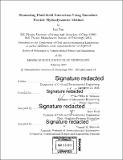Simulating fluid-solid interaction using smoothed particle hydrodynamics method
Author(s)
Pan, Kai, Ph. D. Massachusetts Institute of Technology
DownloadFull printable version (11.41Mb)
Other Contributors
Massachusetts Institute of Technology. Department of Civil and Environmental Engineering.
Advisor
John R. Williams.
Terms of use
Metadata
Show full item recordAbstract
The fluid-solid interaction (FSI) is a challenging process for numerical models since it requires accounting for the interactions of deformable materials that are governed by different equations of state. It calls for the modeling of large deformation, geometrical discontinuity, material failure, including crack propagation, and the computation of flow induced loads on evolving fluid-solid interfaces. Using particle methods with no prescribed geometric linkages allows high deformations to be dealt with easily in cases where grid-based methods would introduce difficulties. Smoothed Particle Hydrodynamics (SPH) method is one of the oldest mesh-free methods, and it has gained popularity over the last decades to simulate initially fluids and more recently solids. This dissertation is focused on developing a general numerical modeling framework based on SPH to model the coupled problem, with application to wave impact on floating offshore structures, and the hydraulic fracturing of rocks induced by fluid pressure. An accurate estimate of forces exerted by waves on offshore structures is vital to assess potential risks to structural integrity. The dissertation first explores a weakly compressible SPH method to simulate the wave impact on rigid-body floating structures. Model predictions are validated against two sets of experimental data, namely the dam-break fluid impact on a fixed structure, and the wave induced motion of a floating cube. Following validation, this framework is applied to simulation of the mipact of large waves on an offshore structure. A new numerical technique is proposed for generating multi-modal and multi-directional sea waves with SPH. The waves are generated by moving the side boundaries of the fluid domain according to the sum of Fourier modes, each with its own direction, amplitude and wave frequency. By carefully selecting the amplitudes and the frequencies, the ensemble of wave modes can be chosen to satisfy a real sea wave spectrum. The method is used to simulate an extreme wave event, with generally good agreement between the simulated waves and the recorded real-life data. The second application is the modeling of hydro-fracture initiation and propagation in rocks. A new general SPH numerical coupling method is developed to model the interaction between fluids and solids, which includes non-linear deformation and dynamic fracture initiation and propagation. A Grady-Kipp damage model is employed to model the tensile failure of the solid and a Drucker-Prager plasticity model is used to predict material shear failures. These models are coupled together so that both shear and tensile failures can be simulated within the same scheme. Fluid and solid are treated as a single system for the entire domain, and are computed using the same stress representation within a uniform SPH framework. Two new stress coupling approaches are proposed to maintain the stress continuity at the fluid-solid interface, namely, a continuum approach and stress-boundary-condition approach. A corrected form of the density continuity equation is implemented to handle the density discontinuity of the two phases at the interface. The method is validated against analytic solutions for a hydrostatic problem and for a pressurized borehole in the presence of in-situ stresses. The simulation of hydro-fracture initiation and propagation in the presence of in-situ stresses is also presented. Good results demonstrate that SPH has the potential to accurately simulate the hydraulic-fracturing phenomenon in rocks.
Description
Thesis: Ph. D., Massachusetts Institute of Technology, Department of Civil and Environmental Engineering, 2017. Cataloged from PDF version of thesis. Includes bibliographical references (pages 97-102).
Date issued
2017Department
Massachusetts Institute of Technology. Department of Civil and Environmental EngineeringPublisher
Massachusetts Institute of Technology
Keywords
Civil and Environmental Engineering.